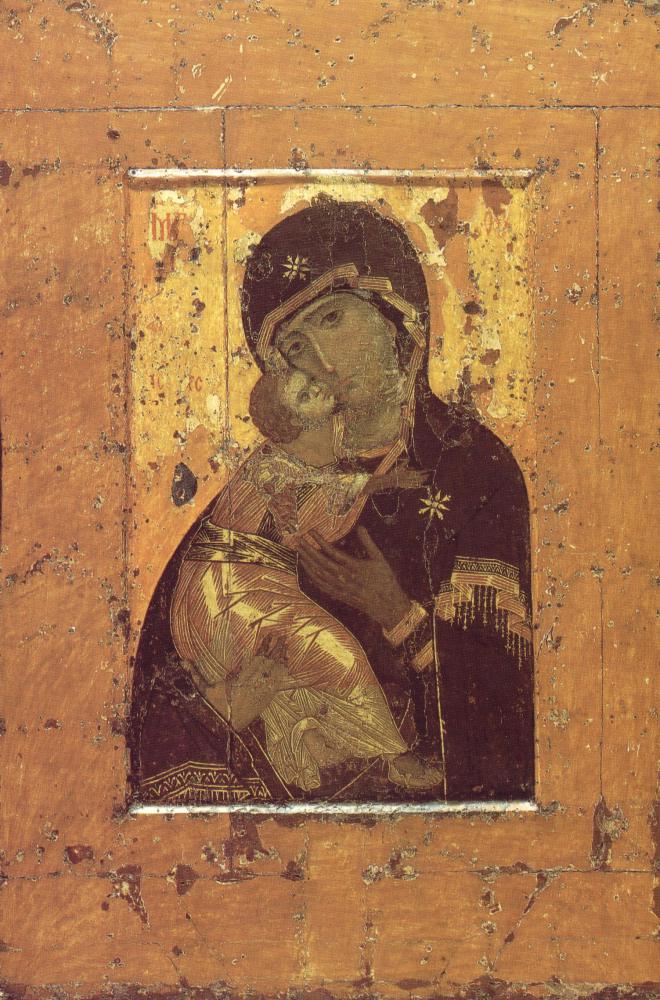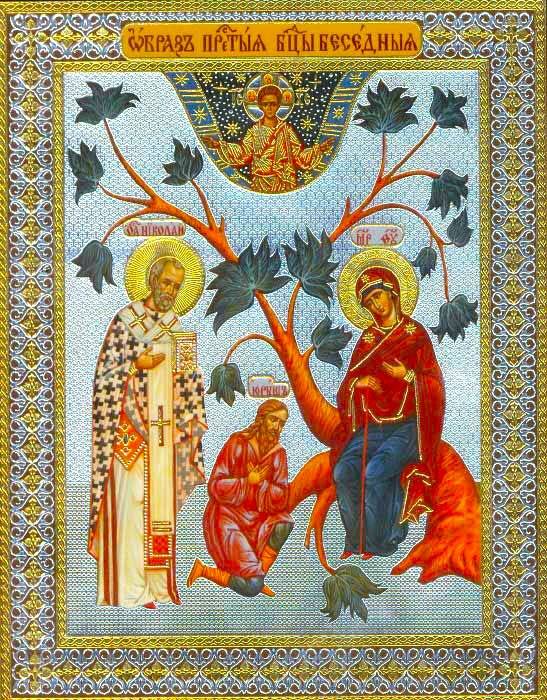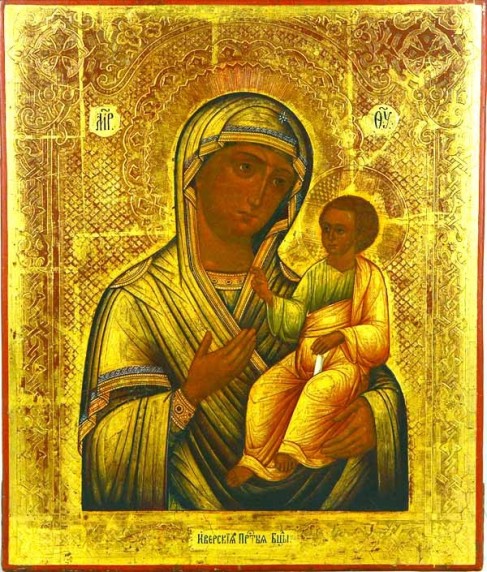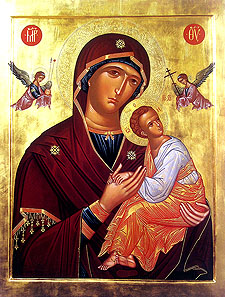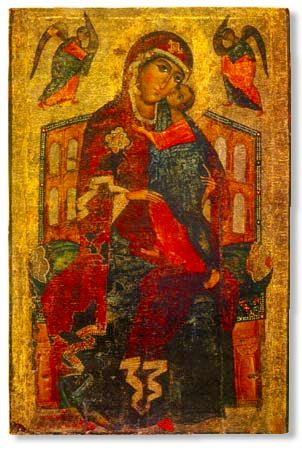O
meraviglia inaudita! La fonte della vita viene po-sta nella tomba e il
sepolcro diventa scala verso il cielo. Rallegrati, o Getzemani, sacro
santuario della Madre di Dio! Acclamiamola, fedeli, avendo per corifeo
Gabriele: Rallegrati, Piena-di-grazia, il Signore è teco, Lui che
accorda al mondo, attraverso te, copiosa misericordia .
Le
Potenze, i Troni, i Principati, le Potestà, le Do-minazioni, i Cherubini
e i terribili Serafini glorificano la tua dormizione; i figli della
terra si rallegrano, or-nati della tua divina gloria. I re si prostrano
insieme con gli Arcangeli e gli Angeli e cantano: Rallegrati,
Piena-di-grazia, il Signore è teco, Lui che accorda al mondo, attraverso
te, copiosa misericordia.
- Gli apostoli teofori, ad un
cenno di Dio sollevati nell'aria su nuvole dai posti dove si trovavano,
raggiunto il tuo corpo purissimo, principio
di vita, lo baciavano con amore. Le sublimi potenze celesti, giun-te con
il loro Signore, piene di timore scortavano il corpo verginale,
ricettacolo della divinità; avanzavano al di sopra del mondo e senza
essere viste, gridavano alle schiere superiori: 'Ecco che s'avvicina la
divina Fanciulla e universale Regina. Alzate le porte e con sovrumana
magnificenza accogliete la Madre dell'eter-na luce; grazie a lei,
infatti, la salvezza è giunta per tutto il genere umano. Noi non
possiamo fissarla e sia-mo impotenti a renderle il dovuto onore: la sua
so-vrumana dignità supera tutto ciò che si può concepi-re'. Per questo, o
senza macchia Madre di Dio, sempre vivente col Re della vita e Figlio
tuo, prega senza posa perché sia custodito e salvato da ogni insidia
dell'avversario l'insieme dei tuoi figli, perché noi sia-mo sotto la tua
protezione. E noi ti glorifichiamo pub-blicamente per tutti i secoli.
Dalla Litia
Conveniva che coloro che erano
stati i testimoni del Verbo e i suoi servitori, vedessero la Dormizione
della sua Madre secondo la carne, l'ultimo mistero operato in lei; così
sarebbero stati i testimoni non solo dell'Ascensione del Signore, ma
anche del transito di colei che l'aveva messo al mondo. Perciò,
trasportati da ogni luogo dalla forza divina, raggiunsero Sion ed
accompagnarono colei che, superiore ai Cherubini, se ne andava in cielo.
Con loro, anche noi prosterniamoci dinanzi a lei, poiché intercede per
le nostre anime.
Colei
che è più sublime dei cieli, più gloriosa dei Cherubini e più venerabile
di ogni creatura e che per la sua eminente purezza è divenuta
ricettacolo del-l'Essere eterno, oggi rimette la sua anima tra le mani
del Figlio ; e con lei l'universo si riempie di gioia e a noi viene
donata copiosa misericordia.
Gli Apostica
Venite, popoli, cantiamo la pura e
tutta santa Ver-gine, da cui è ineffabilmente venuto, dopo essersi
incarnato, il Verbo del Padre, e diciamole a gran voce: Benedetta tu fra
le donne, e beato il seno che ha
con-tenuto Cristo. Prega Colui, tra le cui santissime mani hai rimesso
l'anima, affinché salvi le nostre anime.
R.: Alzati, Signore, verso il luogo del tuo riposo, tu e l'arca della
tua santità (Sal. 131, 8).
La
gloriosissima tua dormizione, pura e tutta santa Vergine, noi la diciamo
beata con la moltitudine degli Angeli in cielo e con il genere umano
sulla terra, perché sei divenuta la Madre del Creatore di tutti, Cristo
Dio. Non cessare di pregarlo per noi, te ne supplichiamo, noi che
in te, dopo Dio, mettiamo la nostra speranza, o Madre di Dio, esaltata
nei nostri inni ed ignara di nozze.
R.: Il Signore ha giurato a Davide il vero e non ritratterà la sua
parola: Il frutto delle tue viscere, io metterò sul tuo trono (Sal. 131,
11).
In
questo giorno, popoli, cantiamo a Cristo Dio l'inno davidico. Egli
disse: Al re saran condotte le vergini al seguito di lei; le sue vicine
saran condotte nella gioia ed esultanza! Poiché colei che è della
stir-pe di David e grazie alla quale siamo stati diviniz-zati, viene
gloriosamente ed ineffabilmente rimessa nelle mani del suo proprio
Figlio e Signore. Inneg-giando a lei quale Madre di Dio, diciamole a
gran voce: Salvaci da ogni insidia, noi che ti proclamiamo Theotókos, e
libera dai pericoli le nostre anime.
Quando sei trapassata, o Vergine
Deipara, a Colui che da te nacque in modo ineffabile, erano presenti
Giacomo, fratello del Signore e primo gerarca, Pietro, gloriosissimo
Corifeo e capo dei teologi, e tutto il coro divino degli Apostoli. Con
inni rivelatori del di-vino, essi cantavano il mistero inaudito e
superno dell'economia di Cristo nostro Dio; e seppellendo il tuo corpo,
principio della vita e ricettacolo della divi-nità, si rallegravano, o
degnissima dei nostri canti. Sopra a
loro, le santissime e venerabili Potenze ange-liche si meravigliavano
del portento e prosternandosi dicevano l'una all'altra; 'Spalancate le
vostre porte ed accogliete colei che ha partorito il Creatore del cielo e
della terra; nelle nostre dossologie celebriamo il ve-nerabile e santo
corpo che ha contenuto il Signore per noi invisibile'. Perciò,
festeggiando anche noi la tua memoria, ti gridiamo, o tutta degna dei
nostri canti: Risolleva la forza dei cristiani e salva le nostre anime.
Tropario
Nella
maternità hai conservato la verginità e nella dormizione non hai
abbandonato il mondo, o Madre di Dio; sei stata trasferita alla Vita
essendo madre della Vita e con le tue preghiere liberi dalla morte le
nostre anime.
 http://www.johnsanidopoulos.com/2010/08/holy-belt-zoni-of-theotokos.html
http://www.johnsanidopoulos.com/2010/08/holy-belt-zoni-of-theotokos.html



